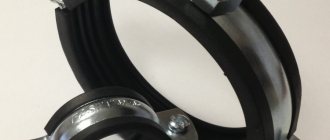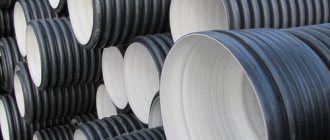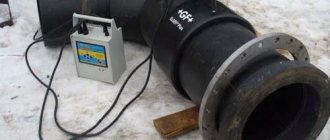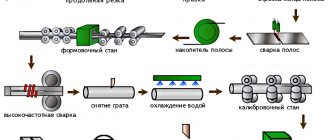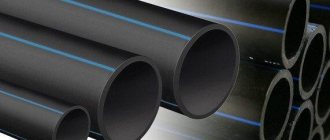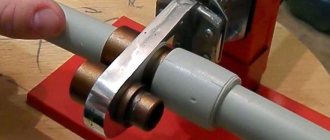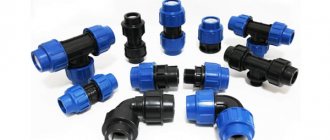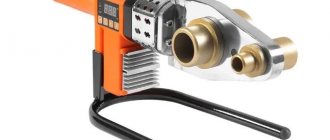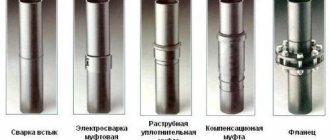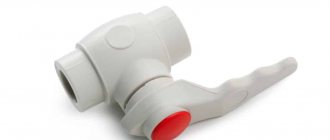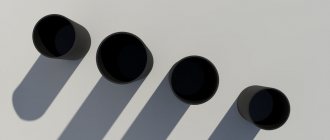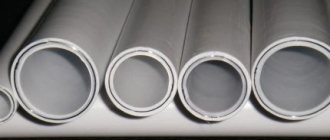When purchasing polyethylene pipes for installing communication systems for home or industrial purposes, you can see markings applied to them with a set of various data about a specific product. It contains:
- information about the pipe manufacturer,
- numbers of GOST standards in accordance with which it was manufactured,
- abbreviation “PE”, meaning that the pipes are made of polyethylene - a thermoplastic polymer of the hydrocarbon “ethylene”, and its brand (PE-100, PE-80, etc.),
- diameter of the product and thickness of the material of its walls,
- as well as the abbreviation SDR with a certain index.
In this case, the SDR of polyethylene pipes is a strength value by which the capabilities of pipe products can be most accurately determined.
Marking PE pipe
The PE pipe marking indicates that the raw material for production was polyethylene (PE), obtained by polymerization of ethylene, which has high thermal insulation and dielectric properties.
PE pipes are flexible, durable, and non-toxic, which allows them to be used for water pipes (including drinking water).
Advantages of PE pipes:
- polyethylene pipes do not react to alkaline preparations, hydrochloric acid, gasoline, alcohol, and various oils;
- resistant to impacts, do not crumble at sub-zero temperatures, pipe walls are vapor-tight;
- easy and simple installation by hot soldering. With proper operation, it can function for several decades;
- smooth internal and external surfaces are not subject to corrosion by salts, organic solvents, bacteria and microbes dissolved in water, and do not have limescale build-up;
- increased throughput compared to metal products;
- the high coefficient of linear expansion of polyethylene allows the pipe walls to stretch if the water freezes there in winter;
- polyethylene pipes do not require thermal insulation.
What other characteristics need to be taken into account?
In addition to SDR, it would be useful to find out the weight of 1 linear meter. This way you can calculate the volume of the pipe, which will help you order a vehicle of the required cubic capacity.
Polyethylene. Please note that when choosing a pipe according to the SDR, you must know the brand of polyethylene from which the pipe is made. Today, most manufacturers use PE 100. The newest raw materials have an improved structure and increased density, which ensures long-term operation of the finished product.
GOSTs and TU. PE pipes are manufactured according to GOST if they are to be used in pressure networks transporting drinking and household water. You can distinguish such a pipe by the blue stripes along the body. By the way, yellow stripes are used to mark PE gas pipes. The generally accepted GOST for water pipes is 18599-2001. As for the specifications (technical conditions), the situation here is different. There is no single prescriptive document; each manufacturer creates it independently. Of course, not out of thin air, but guided by the tolerances of the same GOST.
Release form. Traditionally, polyethylene pipes are made in lengths and coils. The first consists of whips 6.16 meters long. Coils are pipes of small diameters wound into a roll (from 10 to 63 mm). Other standard sizes are supplied in lengths. Information about this is usually contained in the description, or it is communicated by the manager during a telephone conversation.
SDR marking
SDR (Standard Dimension Ratio) is the ratio of the outer diameter of a polyethylene (or any other) pipe to the thickness of its wall.
Thus, with an increase in the SDR index, the pipe wall becomes thinner, and vice versa, the wall thickness increases with a decrease in the index, i.e. The higher the SDR value, the thinner the pipe.
Previously, the indicator of the performance characteristics of polyethylene pipes was the MRS (Minimum Required Strength) standard, which shows the minimum load under which the pipes will remain intact and undamaged.
GOST 18599-2001, which is called “Polyethylene pressure pipes,” regulates the quality of pipes and describes their main technical parameters, including the diameters of polyethylene pipes.
Classification of electric welded fittings
There are several varieties of fittings such as electric welded couplings for polyethylene pipes; their sizes vary from 2 to 31.5 cm.
According to their characteristics, electric welded couplings for polyethylene pipes, regardless of size, differ from each other. Some are used to seal the water supply system, others - gas.
However, today electric welded products of a universal type are already produced, which can be used in pipelines for any purpose.
Video 2
Application area
A wide range of applications include electric welded couplings for polyethylene pipes. The sizes most often used are from 2 to 11 cm. They are an indispensable element during the installation of pipeline systems for any purpose and engineering structures.
The PE100 coupling is mainly used when performing repair work in cramped conditions, for example, in a trench.
Due to the minimal amount of time required for welding, the PE100SDR11 product is an ideal solution for emergency situations.
It is also used during the installation of branching pipeline systems and when creating additional branches from an already installed water supply system.
And in any other cases when it is not possible to carry out a butt welding connection.
Video 3
According to the installation technology of PE100 SDR11, it can be performed in a wide range of temperature conditions, which allows installation and repair work to be carried out both in the winter cold and in the summer heat.
Choosing the right electrofusion fittings
Today on the construction market you can see a huge range of PE electric-welded couplings from different manufacturers
Initially, you should pay attention to customer reviews and recommendations of professionals.
Video 4
When installed correctly in accordance with all GOSTs and standards, couplings for polyethylene pipe products serve faithfully for many years. Using these fittings, a homogeneous sealed structure is ultimately formed.
The main thing to remember is that the final result is influenced by both the quality of the connecting element and the welding machine.
Pipes PE 80 SDR 21
Low-pressure pipes used in private housing construction for non-pressure sewerage in a small one-story building, as well as drinking water supply. They are not suitable for creating pressure water systems in high-rise buildings, because thin walls will not withstand such a heavy load. Also, they cannot be buried in the ground; soil pressure can lead to an accident.
The SDR 21 marking indicates that with a constant load of 6 atmospheres and a water temperature of 20°C, the pipes will serve uninterruptedly for up to 50 years. They begin to deform at water temperatures above +40°C.
Pipes PE 80 SDR 17
The polyethylene pipe SDR 17 is distinguished by the average value of the ratio of the outer diameter of the pipes produced today to the thickness of their wall. PE 80 SDR 17 pipes are recommended for use in a very wide range. For water supply systems intended to supply drinking water, for water supply systems for household purposes from water treatment facilities to the consumer, also for the installation of irrigation systems.
The choice of these pipes for installing communications in a low-rise building is considered optimal, since their installation will ensure high strength, lightness of the pipelines, and the cost of purchasing the material will be relatively low.
At a water temperature of 20°C, the pipes will withstand a load of 8 atmospheres. They are good for private housing construction, but such pipes are not suitable for high-rise buildings.
Areas of household application for polypropylene (PP) pipes and their operational parameters
Polypropylene pipelines connected by soldering are widely used in households for laying internal communications for cold and hot water supply, heating, as well as externally in caisson wells.
There are three main types of polypropylene pipes: from the usual random copolymer PP-R, reinforced with fiberglass and aluminum foil. More modern developments from the world's leading manufacturers made from heat-stabilized or basalt fiber-reinforced PP are much more expensive than traditional ones and are not so often found on the market.
Pipes PE 80 SDR 13.6
PE 80 SDR 13.6 pipes are low-pressure pipes and are recommended for use in the installation of pipelines transporting cold drinking water for various needs in country houses, and pipes allow the transport of liquid food products (wine, juice, milk). Compared to cast iron or steel pipes, polyethylene analogues are much stronger, while they are lightweight and are installed by hot soldering.
They belong to the category of products made from low-density polyethylene, which makes them the most durable among the PE-80 brand. After all, its working pressure can be considered 10 atmospheres. The pipe walls are able to withstand a temperature range from -40°C to +60°C, so they can be used in northern latitudes.
General differences
At the moment, polyethylene pipes are produced with SDR from 6 to 41, for which the possible loads are presented in the following table by “pressure classes”:
| SDR 6 | SDR 7.4 | SDR 9 | SDR 11 | SDR 13.6 | SDR 17 | SDR 17.6 | SDR 21 | SDR 26 | SDR 33 | SDR 41 |
| 25 atm | 20 atm | 16 atm | 12 atm | 10 atm | 8 atm | 7 atm | 6 atm | 5 atm | 4 atm | 4 atm |
Thus, the standard dimensional coefficient can be used when determining the purpose of the pipe for specific systems - pressure and non-pressure, namely:
- Pipes with index SDR 26-41 are used for free-flow (gravity) sewer outlets;
- With indicators of 21-26 they can already be used for intra-house low-pressure water supply to low-rise buildings;
- Products indexed with an index from 11 to 17 can be used for the construction of low-pressure water supply and irrigation systems;
- Pipes with an SDR greater than or equal to 9 are suitable for pressure systems intended for water supply, construction of pressure sewer collectors and even gas pipelines.
PE 100 SDR 26
For the production of such pipes, PE100 polyethylene is used, the distinctive qualities of which are high density, due to which pipes made from this material are superior to products made from PE80 in many respects, including long-term strength and resistance to cracking.
These pipes are used for transporting household and drinking water in urban areas and outside the city; they can also be used in sewerage systems, when drilling artesian wells, and creating a reclamation system. In factories and factories they will serve to supply milk, juice or wine.
In addition, the quality indicators of the material made it possible to significantly reduce the thickness of the walls of the product, which lightened its weight, but at the same time their throughput was 10-15% higher. The working pressure can be considered 6.3 atmospheres.
Polyethylene grades
Grade PE 80, PE 63, PE 100 corresponds to the strength index MRS 8; 6.3 and 10, i.e., means the minimum long-term strength of the polyethylene from which these pipes are made. Pipe polyethylene of these grades is obtained from a rigid polymer with a linear structure and a high degree of crystallinity. These products have good resistance to most inorganic and organic acids, petroleum carbons, alkalis, salts, etc.
Polyethylene grades PE 100, PE 80 and PE 63 are widely used nowadays; its main distinguishing feature is density, strength and, of course, cost.
PE 32 SDR pipe is also produced, its quality is regulated by GOST 18599-2001, its scope of use is water supply (at a nominal pressure of 2.5 atm.) and sewerage.
It seems that PE 100 is the most reliable, durable and cheaper grade of polyethylene; in fact, each of these grades has its own individual application.
Gas pipe
In addition, such pipes have a visual difference depending on their purpose. For example, pipes with a blue stripe are used to install a drinking water supply system, and products with a yellow stripe are used to lay a gas pipeline.
PE 100 pipe
It is characterized by high working pressure, maximum tensile strength and resistance to mechanical stress. Certified raw materials are used for its production. Qualitative characteristics made it possible to reduce the wall thickness of this product and reduce its weight. Pipes of this brand are most often used for the following purposes:
- installation of water and gas pipelines;
- installation of pipelines for supplying food products in liquid form (juices, milk, wine, beer, etc.).
PE pipeline installation process
PE 80 pipe
These products are wear-resistant, quite lightweight, and medium-pressure plastic is used for their manufacture. Pipes of this brand belong to low-pressure pipes, the main purpose of which is the installation of low-pressure and free-pressure sewerage systems in multi-apartment residential buildings. In addition, they can be used to install small-diameter pressure water supply in a small area.
The products are certified and can be used for their intended purpose.
PE 80 pipe
At the same time, experts do not recommend using them in some cases. Due to the small thickness of the wall, it is not recommended to install gas pipelines and main pipelines from such products.
PE 63 pipe
This grade of polyethylene contains mainly ethylene molecules; it is characterized by short-term strength, but at the same time it is prone to cracking and destruction. Due to these characteristics, it is less often used in civil and industrial construction for the construction of drainage systems of road communications, basements of buildings, foundations and sites.
These pipes are used in the laying of electrical cables and fiber optic lines, where they are used as a casing for utility lines. Sometimes these pipes are used in agriculture; with their help, moisture is drained from waterlogged areas and swamps.
PE 100 SDR 21
PE 100 SDR 21 pipes are used for the construction of water pipelines. Passing through pipes of this type, water retains its taste and is characterized by the absence of foreign odors. They are often used not only in suburban construction, but also to create reclamation and irrigation systems, and when installing suburban water supply systems. High-strength polyethylene can withstand high pressure, and PE 100 SDR 21 pipes can be used as an element of a cold water supply system in high-rise buildings.
These pipes have excellent strength characteristics and are ideal for water supply. They are compatible with metal pipes (steel, cast iron) using special adapters. Corrosion processes, other types of destruction and blockages in such pipes are not dangerous. At a constant water temperature of +20°C, the pipes can withstand a pressure of 8 atmospheres.
PE 100 SDR 17
Pipes marked PE 100 SDR 17 are new generation pipes. Their feature is uniquely high strength indicators, which has a significant impact on enhancing the performance characteristics of polyethylene pipes. They tolerate constant pressure of 10 atmospheres well.
Pipes of this type are recommended for use in pressure water supply systems and gas pipelines. Moreover, such pipes are considered ideal for the installation of pipelines with a large cross-section. When manufacturing pipes of this type, material savings are very significant due to the possibility of reducing the wall thickness while maintaining the high strength of the product. The technical characteristics of such pipes allow their widespread use in the construction of long-distance pipelines.
Tips on how to choose
HDPE is the optimal choice for installation in the ground or basements without ultraviolet rays, sudden temperature changes and mechanical vibrations. When choosing the type and size of pipes, they are guided by the purpose and operating conditions. First, the purpose of the pipelines is determined - pressure and non-pressure, sealed or not. Power, telephone or Internet networks are laid in casings made of larger tubes; often these pipelines are not sealed.
The second important factor is the working pressure in the water supply or soil pressure on free-flow networks. The choice of pipe design (smooth-walled, corrugated, double-layer corrugated, bell-shaped) depends on these factors. In addition, the temperature regime is taken into account - overheating of the ground in summer, freezing in winter.
The choice of pipe parameters for sewerage depends on the weight of the overlying soil layer. If the depth is more than 5–6 m or the sewage system is located under a platform for cars, use corrugated two-layer pipes with high ring rigidity. Corrugation is also used for deep laying of water pipes and a large layer of screed over a heated floor system.
When choosing materials in a store, it is better to choose products from well-known brands. Corrugation is definitely better than imported ones. Smooth-walled pipes can also be selected from domestic manufacturers.
Approximate price and best manufacturers
The best domestic ones, “Kazanorgsintez”, “TekhStroyPolymer”, “PolyPlastik”, “BaltEnergosystems”. There are many imported manufacturers, but the quality of imported HDPE pipes is not much higher than domestic ones, but the price is significantly different. The availability and prices of pipes from foreign manufacturers must be determined separately for each region: the range and prices are very different!
Price of popular domestically produced products:
- 1 m of smooth-walled water pipe Ø 32 mm costs from 50 mm, Ø 40 mm - from 70 rubles;
- 1 m of single-layer corrugated pipe Ø 50 mm costs approximately 60 rubles; Ø 63 mm – 90 rubles; Ø 110 mm – 150 rubles;
- bell-shaped HDPE design with a running size of 110 mm and a length of 2 m costs about 300 rubles; corrugated - about 400 rubles.
PE 100 SDR 11
The PE100 SDR 11 pipe is made from polyethylene produced at low pressure. At the same time, the high density of the material allows the use of such pipes for water supply systems with high pressure. The material used for the manufacture of pipes ensures high quality and environmental safety of drinking water.
Reliable and strong, they are able to withstand constant pressure of 16 atmospheres for 50 years. Such reliability and tolerance to aggressive environments makes it possible to use these pipes for gasification of populated areas. They are not afraid of stray currents, they can easily withstand variable soil loads. Pipes of this brand can be laid using the pulling method in the ground. The density of polyethylene allows them to be used as sewer collectors.
